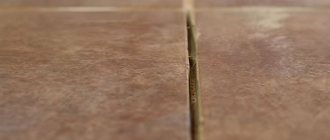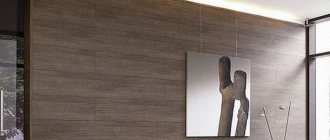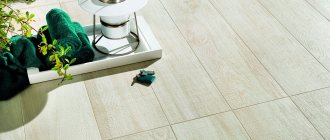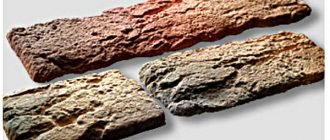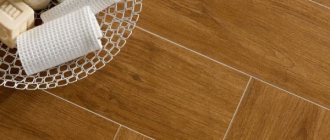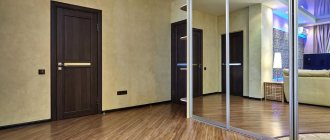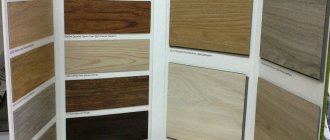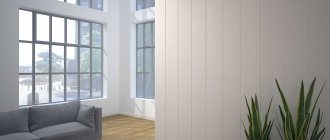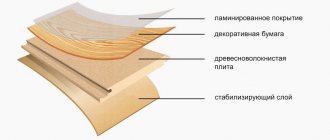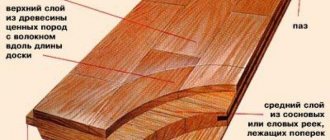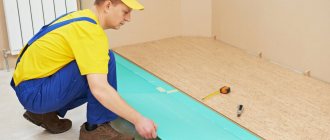02.05.2011
The very first question that arises among buyers of finishing materials is whether porcelain tiles can be laid on walls? Many people know that this material is used for façade cladding and for forming floor surfaces. However, it is also known that this material is quite heavy. The weight of a 3 cm thick tile can reach more than 150 kg if the dimensions of the cladding fragment are 120x180 or 120x190 cm.
And yet, porcelain stoneware is not as heavy as natural stone, and its colors are so diverse that they allow you to create real masterpieces on the walls in the form of artistic cladding or panels. The scope of application has expanded not so long ago, although porcelain tiles have been represented on the building materials market for several decades.
The development of the construction of modern structures with curtain facades provides porcelain stoneware with the opportunity to successfully compete with glass, which in terms of specific gravity, depending on the type, can even exceed porcelain stoneware by 3 times, as is the case with lead oxide glass. The ability to effectively imitate natural stone, wood, leather and other materials makes porcelain tiles an interesting material for exterior and interior designers.
Laying porcelain tiles on the wall is carried out using two technologies:
- using a complex system of supporting frame made of guide profiles onto which the cladding is attached. This scheme is convenient when finishing buildings using the technology of suspended ventilated facades;
- finishing walls with porcelain tiles using construction adhesives. This method is used when decorating interior walls of various rooms and spaces.
Naturally, when choosing facing fragments, various factors that will affect the coating are taken into account. Depending on this, the type, format and thickness of the finishing material is selected. And depending on the design project, the color of the porcelain stoneware is selected, which can be monochromatic, full-color, natural materials, or even mosaic fragments for wall decoration.
Laying porcelain tiles on the wall: installation instructions
The very first question that arises among buyers of finishing materials is whether porcelain tiles can be laid on walls?
Many people know that this material is used for façade cladding and for forming floor surfaces. However, it is also known that this material is quite heavy. The weight of a tile 3 cm thick can reach more than 150 kg if the dimensions of the cladding fragment are 120x180 or 120x190 cm. Yet porcelain tile is not as heavy as natural stone, and its colors are so diverse that they allow you to create real masterpieces on the walls in the form of artistic cladding or panel The scope of application has expanded not so long ago, although porcelain tiles have been represented on the building materials market for several decades.
The development of the construction of modern structures with curtain facades provides porcelain stoneware with the opportunity to successfully compete with glass, which in terms of specific gravity, depending on the type, can even exceed porcelain stoneware by 3 times, as is the case with lead oxide glass. The ability to effectively imitate natural stone, wood, leather and other materials makes porcelain tiles an interesting material for exterior and interior designers.
Laying porcelain tiles on the wall is carried out using two technologies:
Naturally, when choosing facing fragments, various factors that will affect the coating are taken into account. Depending on this, the type, format and thickness of the finishing material is selected. And depending on the design project, the color of the porcelain stoneware is selected, which can be monochromatic, full-color, natural materials, or even mosaic fragments for wall decoration.
Porcelain tiles and tiles, similarities and differences
These materials are identical in composition, the main difference lies in the technology. When producing porcelain tiles, dyes are immediately added to the main substances (no synthetic substances, only natural substances). Everything is mixed well and the desired tile shape is formed. It is pressed and baked under enormous pressure at high temperatures.
Clay becomes stronger than granite and marble. There are no pores in it, so the moisture resistance of porcelain stoneware is lower than that of brick.
The tile is a base coated with a glaze that can wear away over time, exposing the gray backing.
The choice of porcelain stoneware and tiles on the market is huge.
What do you need to know about laying porcelain tiles?
Laying porcelain tiles on the wall is done in stages. Due to the fact that the material is characterized by a low degree of porosity, it does not absorb conventional ceramic tile adhesive. A truly durable and reliable installation on the wall can only be done using construction adhesive with plasticizers. When forming wall decoration, it is necessary that the glue has thixotropic ability to eliminate the phenomenon of sliding of porcelain stoneware fragments.
There are two known methods of laying porcelain tiles with an adhesive composition:
Wall cladding with porcelain stoneware is carried out with the aim of bringing the room up to standards and compliance with sanitary and hygienic rules and requirements. Typically, this finishing method is used in the food industry or medical institutions. However, today this material is widely used in the design of walls of buildings and structures of enterprises in other industries. Mainly matte or satin material is used for floors and glossy tiles for walls.
The material is placed on a perfectly flat base, free from dirt and dust. An even base is a requirement that ensures the long-term operation of the coating, without cracking due to unequal internal stress.
For grouting, epoxy material is used, matched to the color of the tile. It is the grout that acts as a buffer shock absorber, allowing the cladding to expand when heated. The role of epoxy filler in tile joints is extremely important when installing a porcelain stoneware coating on top of a heated floor system. When laying on a wall, compositions with average characteristics are usually used, since the surface is practically not subjected to mechanical stress and is heated only by the air temperature in the room. Unless we are talking about lining stoves or fireplaces. When finishing them, this material is used most often, since it is resistant to high temperatures and does not lose its properties even under very high heat.
To figure out how to lay porcelain tiles on a wall, let’s go through the steps of the instructions “Cladding walls with porcelain tiles.”
Do I need to grout porcelain tiles?
After laying porcelain tiles, a mandatory grouting procedure is carried out, which is performed to ensure protection from moisture, protection from debris, and also to ensure the necessary artistic and aesthetic properties. Grouting is also sometimes called jointing or jointing.
Interesting materials:
What is stunning in Russian examples? What are Homoforms in Russian? What is orthoepy in Russian definition? What are spelling patterns in the Russian language? What are negative sentences in Russian? What is a transitive form in Russian? What is a first language? What is a sentence in Russian rules? What are prefixes in Russian? What is participle 2 in German?
Technological features of laying porcelain tiles on wall surfaces
Wall cladding with porcelain stoneware takes place in accordance with the following sequence of stages:
How to prepare the base for laying tiles?
Preparatory work for processing walls for tiles includes the following steps:
How to prepare porcelain tiles for installation?
The protective layer on the back side of the tile must be removed. It can be made from paraffin, which is cleaned with a spatula, or from technical wax, to remove which you will have to use warm water and detergent.
If there are sockets, switches and other elements on the wall surface, it is necessary to first make holes in the tile of the required shape with the appropriate dimensions. Porcelain tiles can be cut at home, but if it is necessary to cut the tiles in accordance with the designer’s design, and fragments of complex geometric shapes are needed, which is usually the case with elaborate wall panels, it is advisable to use waterjet cutting services. Such services are provided by companies working with stone.
You can cut holes for sockets and switches at home. To do this, you can use a “ballerina” or a circular saw. An electric jigsaw is also used, the string of which has an abrasive coating.
You can cut porcelain stoneware diagonally and cut off the excess surface of the tile using a mechanical or electric tile cutter, as well as a grinder. For this process, it is necessary to use abrasive discs for processing stone or discs for porcelain stoneware with a cutting edge height greater than the thickness of the finishing material.
How to prepare an adhesive composition for facing work?
The use of tiles whose size exceeds the 400x400 mm format requires the use of glue for large-format tiles. The greater the thickness of the porcelain tiles, and it can vary from 4 to 9 mm, the larger the layer of adhesive that needs to be applied (3-5 mm). This must be taken into account when calculating consumption and buy glue with a small margin.
If porcelain tiles will be laid on an iron, wooden or plastic base, it is better to use an adhesive composition based on polyurethane or epoxy. The adhesive properties of adhesive intended for porcelain tiles should be higher than that of adhesive for ceramic tiles.
Tile adhesive must be prepared in accordance with the instructions; the consistency of the adhesive composition should resemble sour cream.
The adhesive can be applied to the wall or to the surface of the tile, but for large-format and heavy tiles it is better to treat both surfaces.
How to lay tiles on a wall?
Finishing wall surfaces with porcelain stoneware requires professionalism and skill. The tiles are laid from the bottom to the top row, unless otherwise provided by the design project. The tile is placed edgewise to the adjacent facing fragment, pressed against the wall and moved to the place where it should be in accordance with the markings. This prevents an excessive amount of glue in the grooves between the porcelain tiles. Then the tile is tapped with a rubber hammer.
All cut tiles should be located in the inner corners. The lines of tile seams in the presence of door or window openings on the wall should be located at the same level, unless the designer decides otherwise.
How to joint grooves between tiles?
The width of the grooves between the porcelain tiles is maintained using special mounting crosses that do not allow the tiles to move closer.
The jointing mixture is applied after 6-8 hours. This is the time required for the adhesive to dry at a temperature of +23 degrees.
All seams are filled with epoxy jointer using a trowel, and the excess is removed with a damp sponge and the surface is wiped with a dry soft cloth.
What should you not forget?
About what needs to be done after finishing the facing work. Carefully clean the surface of the porcelain stoneware from dirt and leave for a day.
Source
Installation of porcelain tiles
Decorating walls with this material requires professionalism and skill. Tiles are laid from the bottom row to the top.
The tile is laid on the adjacent tile, pressed against the wall, and pushed into place in accordance with the markings. This prevents excess adhesive from accumulating in the grooves between the ceramic tiles.
Then the tile is tapped with a rubber hammer.
Laying porcelain tiles can seem like a daunting task for a beginner.
Cut tiles should be laid in inner corners. If there are door or window openings, the grout lines between the tiles should be even.
Wall cladding with porcelain stoneware: making a choice
Wall cladding with marble is becoming increasingly rare. This is perhaps an expensive material, but porcelain stoneware wall cladding is being used more and more often and there are reasons for this. Let's try to understand these materials and decide what is best. Marble for wall cladding is undoubtedly prestigious, but natural materials are increasingly being replaced by artificial ones.
Advantages and disadvantages
Stone-like porcelain stoneware, like any material, has its advantages and disadvantages. The advantages include the following properties:
- Stability and color constancy - the tiles do not fade in the sun and retain their appearance for decades.
- Resistant to both high temperatures and frost.
- Wear resistance and resistance to mechanical damage.
- The tile is not afraid of alkali or acid, so care can be carried out even with the help of aggressive chemicals.
- The environmental friendliness of raw materials and production makes the material safe for people and the environment.
Disadvantages include:
- High density makes porcelain stoneware products heavy. Transporting and stowing them is not easy.
- Difficulties in processing - cutting the tiles evenly and processing the edges is only possible with special equipment. This cannot be done in everyday life.
- It costs more than regular tiles, so you will have to fork out for repairs.
- There are restrictions on the color palette and texture. There is a much larger selection of tiles.
Differences between porcelain stoneware and marble
Granite has been used for wall cladding for a long time. It is perfectly preserved over time, but it also has its drawbacks:
From this series you can also look at granite. Wall cladding with granite is also not done so often, but is sometimes used. Cladding walls with granite slabs, as well as marble, is a rather labor-intensive process. Which is not only expensive, but the material is also quite difficult to process. And in terms of strength, porcelain stoneware is perhaps not inferior to it. And the price is much lower. And if you do the finishing yourself, then it’s easier and simpler to do and, importantly, cheaper. And in this matter, wall cladding with granite loses. Cladding walls with granite is not a very simple and easy job, the material is not so easy to process. Now let's take a closer look at porcelain stoneware itself. With its advantages and disadvantages.
Advantages and disadvantages of porcelain stoneware finishing
This material has its pros and cons:
Attention: Before using this material, you should consult with specialists regarding the foundation. It is likely that it will have to be strengthened. After all, the load will increase significantly.
How to properly glue porcelain tiles?
The glue should be mixed until it becomes thick sour cream and in small portions, since its application period does not exceed 15 minutes. For good adhesion of porcelain stoneware to the floor surface and the absence of air gaps, you must first apply a small layer of glue to the floor, level it with a flat, then a notched trowel.
Interesting materials:
Where does muscle energy come from? Where do Chinese cabbage come from? Where did the hacker mask come from? Where did the Ukrainian nation come from? Where did the coats of arms come from? Where did marathon running come from? Where did they call 904 from? Why does 0 squared equal 1? Why don't British cats like to be held? Why does Excel remove leading zeros?
Porcelain tiles - installation methods and subtleties
Wall cladding with porcelain tiles is carried out in one of two ways - fastening with glue and installing ventilated curtain walls.
Gluing
This installation method is very similar to the technology of fixing porcelain stoneware on the inside of walls and floors. The main difference is that different adhesives are used. It is necessary that they are resistant to changes in weather conditions, humidity and temperatures.
Attention: This option is only applicable when the air temperature is above zero. This installation method is usually used when finishing the basement; the second method is more suitable for walls.
What is important with this finishing method:
Ventilated facades made of porcelain stoneware
This method is easier for self-installation. At the same time, it allows you to additionally insulate the building, which is the main advantage of all types of ventilated facades. The technology of this finishing method has long been verified and worked out, so let’s just briefly recall the main nuances:
Attention: Without an air gap, air circulation will become impossible, but it is air flows that provide protection in frosty weather and remove excess heat in the hot season.
Porcelain tiles for wall cladding are attached in two ways:
Metal T-shaped profiles that make up the frame to which porcelain stoneware slabs are attached allow you to secure the cladding using clips, self-tapping screws, clamps or rivets.
Types of hidden fastening
Porcelain tile wall cladding has several types of installation. They differ in the method of fastening:
Cutting porcelain stoneware
As you work, you will have to cut the material. This can be done in the following ways:
If you want to do the cladding of your house yourself, you will definitely need detailed installation instructions. Additionally, you can watch a video from which you will learn the intricacies of all stages of finishing. Porcelain tiles are more suitable as cladding when installing ventilated facades. They will protect the walls from unnecessary environmental influences. Insulation, additionally added during the installation process, will allow the walls to “breathe” and remove excess moisture. This means that living in such a house will be much more comfortable.
Source
Technical characteristics of porcelain tiles for walls
The unique properties of ceramic granite allow it to be widely used for exterior and interior decoration of buildings. During the installation process, artificial and natural stones behave differently. When polymerizing an adhesive mixture with natural stone, the composition, penetrating into its microcracks and pores, can spoil the surface of the cladding by causing stains to appear, which will then be impossible to get rid of. Ceramic granite does not have this drawback.
Despite the fact that it is of artificial origin, the advantages of the material are undoubted:
- Low percentage of water absorption - less than 0.05% by weight, ensuring frost resistance of the material; for natural granite this figure is 5%.
Resistance to solar radiation, chemicals and temperature changes.
High impact and bending strength.
Possibility of creating a structural non-slip surface.
Long-term service life of the coating and no special maintenance.
High level of fire resistance, the material does not ignite.
- A huge range of slabs of various shapes, colors and textures of their surfaces, allowing you to create numerous options for wall decoration with an unusual design.
There are very few disadvantages of ceramic granite:
- The significant weight of the material, which additionally loads the building, is why not all houses can be decorated with porcelain tiles.
Ceramic granite is an excellent flooring, especially for areas with heavy traffic: subways, train stations, airports, cinemas, shopping malls and shops. In home interiors, porcelain tiles for walls are used for finishing kitchens, halls, corridors and hallways, as well as for lining swimming pools and bathrooms.
The material is widely used for facade coverings, and is simply irreplaceable as flooring in car washes, garages or workshops. In addition, porcelain stoneware is used for finishing open terraces, stair steps and walls of production workshops. The material performs its functions equally well both outside and inside.
What is special about working with porcelain stoneware?
Slip tiles or porcelain tiles are most similar to eco-class finishing materials due to their high density and natural appearance. The popularity of using porcelain stoneware in interior decoration is due to its high similarity with natural materials, in particular there is a visual similarity with marble and polished sandstone. The high aesthetic value of porcelain stoneware is given by both excellent color fastness and consistency of geometry, which is ensured by rectification of the edges.
Many tilers have found porcelain stoneware to be a very worthy, noble material, but at the same time, its installation requires high skill. Unlike tiles, porcelain stoneware has a significant thickness, which is reflected in a significant increase in the weight of the finishing layer. If this factor is not particularly important when laying on the floor, then wall cladding requires a more careful approach. From a technical point of view it is required:
There is another side to the issue - aesthetic. Porcelain tiles are laid on the floor mainly in a seamless manner, which is not always appropriate when finishing walls. The exact shape of the tiles requires their careful adjustment and alignment: if the chamfer on the tile helps to smooth out installation flaws and deviations from dimensions, then the perfectly smooth and precise edges of the porcelain stoneware must not only be aligned with high precision, but also the seams must be properly rubbed. For these reasons, not all types of textures are suitable for cladding interior walls. Preference should be given to polished, polished and water-jet surface types.
What features does the material have?
Porcelain tiles have the following features:
- It is durable, can be scratched, sanded, and cleaned. The matte finish will withstand everything except diamond.
- Porcelain tiles have no cracks or crevices.
- No risk of electric shock (if there is a washing machine or other electrical appliances in the bathroom).
- Does not react to aggressive chemicals, resistant to any detergents.
Which stone format is best to use?
Ceramic tiles are limited in size due to warping and shrinkage during the annealing process. For porcelain stoneware, the concept of caliber is absent as such; accordingly, it is manufactured in all possible variations of sizes and aspect ratios. It is not so easy to make a choice among all this variety; you need to look for the right approach.
One of the options is the same type of wall and floor cladding. In such cases, it is very convenient to focus on the format of porcelain stoneware laid in a horizontal plane. So, if the floor is covered with 60x60 cm slabs, then for the walls it is recommended to use the same overall size, but with an aspect ratio of 2:1 or 3:1, that is, 20 or 30 cm wide.
If you plan to install porcelain tiles yourself, it is better to give preference to tiles with the most “convenient” format. An amateur’s hands can confidently handle medium-sized stones - from 20 to 45 cm wide and up to 80 cm long. Tiles that are too small will cause difficulties in alignment, and large porcelain tiles will require special devices for gripping and temporary fixation.
For floors, a thickness of porcelain tiles of at least 8 mm is recommended; for walls there are no such restrictions. Even with a thickness of 3 mm, this finish demonstrates excellent resistance to shock and static loads, however, using tiles that are too thin can lead to damage during cutting and processing by inexperienced hands. The optimal thickness range for porcelain tiles for walls is 5–10 mm; thicker stones require temporary fixation and sequential laying of rows with large time intervals necessary for the underlying elements to bond to the base.
Where and how to buy porcelain tiles for the bathroom?
You can buy porcelain tiles for the bathroom in all Santa Ceramics stores in Moscow or place an order by phone +, with delivery to your city, paying the invoice by bank transfer from an individual or legal entity, or by card on this website. In Santa Ceramica salons, Visa and Mastercard cards, as well as cash, are accepted for payment.
Before purchasing tiles, we recommend that you measure the surface area on which porcelain tiles will be laid, and consultants in the salons will help you calculate the exact amount of material.
Suitable types of load-bearing foundations
Not every wall and partition can be faced with porcelain stoneware. The main factor in suitability for this type of finishing is the presence of additional load-bearing capacity comparable to the weight of the tile and adhesive layer. Additionally, the stability of the base should be taken into account - both seismic stability and the tendency of the material itself to linear expansion under the influence of external factors play a role here. The third criterion for the suitability of a substrate is adhesion, but this can almost always be improved with additional preparation.
Almost all enclosing structures have sufficient load-bearing capacity. The exception is walls made of sandwich panels, as well as frame walls with sheet cladding without internal stone lining. An additional limitation for laying porcelain stoneware is the temperature regime of the building: the temperature range inside must be maintained as determined by the adhesive manufacturer, on average it is from +10 °C to +35 °C.
Separately, it is worth mentioning false walls covered with gypsum fiber board or aquapanel. Their flatness, stability and adhesion do not raise any questions, but there are problems with ensuring sufficient load-bearing capacity. Porcelain stoneware requires the construction of a frame subsystem from a profile with a metal thickness of at least 0.6 mm and an increased density of rack elements - no more than 40 cm. The use of ceiling profiles (CD) as frame racks is unacceptable. For cladding, only moisture-resistant types of gypsum plasterboard and gypsum board with a thickness of at least 16 mm with a fastening density of at least 30 screws per m2 should be used.
What is porcelain tile
Dark gray porcelain tile
Porcelain tile is a very durable composite material for cladding buildings both outside and inside. Otherwise, it is called porcelain stoneware or porcelain tiles, since it is produced in the form of flat tiles of different sizes and shades.
It is made from exclusively natural raw materials: sand, white clay of refractory varieties, feldspar and granite chips. This raw material is ground to a powder, various binders are added, and tiles of the required size are formed using a press. This technology allows you to get rid of porosity and air bubbles in the tiles, they become very durable and dense. Then they are dried, a pattern or relief is applied and fired at temperatures above 12000C.
Porcelain tiles are classified according to three main characteristics:
- According to the type of surface treatment.
- According to the method of processing the edges of tiles.
- According to the structure and relief of the material.
The thickness of porcelain stoneware slabs can vary from 7 mm to 30 mm. The usual tiles for wall cladding have a thickness of 7 - 12 mm. Thicker porcelain tiles are suitable for flooring in production areas where heavy equipment moves.
Surface preparation
The general technique for preparing walls for facing with porcelain tiles is the same as before laying ceramic tiles. There are only a few key points; in general, work is being done to correct the geometry and improve adhesion.
Depending on the material of the supporting layer, different leveling methods are used. For brick and block masonry, leveling with cement or gypsum plaster along the beacons is optimal. It is very important that the grooves left after removing the beacons are filled with a material that is as homogeneous as possible with the main covering of the wall. The alignment tolerance is no more than 2 mm/m and no more than 4 mm in the general plane of the wall.
For wooden walls, we can recommend leveling with sheet cladding made of gypsum plasterboard, gypsum fiber board or SML, depending on the climatic conditions of the building and the design features. The assembly of the false wall is necessary to compensate for the shrinkage of the wood; the work technology was described above. It is also possible to level with composite panels based on EPS or PPU, but only if it is technically necessary to provide additional heat and sound insulation.
Absolutely all surfaces must be dust-free and coated with a primer before installation. In general, it is recommended to use a water-dispersed acrylic primer, preferably from the same manufacturer as the adhesive mixture. For application to gypsum plasterboard, deeply penetrating compounds should be used that increase absorbency and adhesion; for plastered walls, strengthening primers that do not reduce porosity are well suited.
Gluing: process and optimal choice of glue
When laying porcelain tiles on walls, it is better to join them with visible seams about 2–3.5 mm thick. In the corners, the joining is done by bevelling, which requires an electric tile cutter with a wheel of the appropriate type. It is convenient to make straight cuts for the manufacture of ordinary trim on a manual tile cutter designed for working with porcelain stoneware. Other tools you will need are a mixer, spacer crosses, wedges and a scraper for clearing seams. The adhesive is applied using a comb spatula, and since the concept of caliber does not apply to porcelain stoneware, the tooth height does not depend on the size and thickness of the tiles and averages 8–10 mm. Leveling creamogranite on the walls is done only with the help of a laser axis builder, comparison of adjacent tiles is done using a straight edge.
The range of adhesives for porcelain tiles is quite wide. There are both overly expensive variants of mixtures with optional qualities (water resistance, frost resistance), and frankly cheap compositions with a clearly underestimated concentration of the polymer binder. The right solution would be to use glue from a trusted supplier, such as Ceresit CM 11, or the cheaper domestic “Moment” Elast. Special brands of adhesives for porcelain tiles, such as Litokol or UNIS, do not always justify the cost of them; mixtures with a high content of elasticizers are recommended when there is insufficient confidence in the quality of adhesion to the base, as well as when laying stones with a format larger than 45x45 cm.
In general, the technique of laying porcelain tiles has much in common with facing conventional tiles, although it differs in more stringent requirements for the quality of leveling. In addition, there are a number of points that must be observed:
Source
What is the best adhesive for porcelain tiles?
The adhesive for laying ceramic granite is selected depending on the material and condition of the base, and a number of other factors. Thus, when choosing a solution for external work, special attention should be paid to frost resistance and moisture resistance.
When laying porcelain stoneware on a heated floor, one of the key characteristics will be the heat resistance of the adhesive and the presence of plasticizer additives.
In any case, the adhesive for porcelain tiles must have impeccable adhesion and elasticity.
The range of dry mixtures for preparing glue for installing porcelain tiles includes dozens of items. Judging by the numerous reviews of the masters themselves, the compositions of the following manufacturers enjoy maximum confidence:
- Ceresit CM 14 Extra is a functional tile adhesive on a cement-mineral basis with polymer modifying fillers. Suitable for light and heavy porcelain and ceramic tiles, artificial and natural facing materials.
Ceresit porcelain tile adhesive is used with equal success for interior and exterior work. The composition is also suitable for underfloor heating systems (can be laid on concrete screeds with water heating).
Ceresit CM 14 Extra has increased adhesion, is elasticized (it contains plasticizers), and the adhesive is water- and frost-resistant. Laying artificial granite with this adhesive can be done at a temperature of 5-30°C.
- Hercules GM-55 is a specialized adhesive for ceramic granite. It is used for performing external and internal work on finishing floors and walls with slabs of natural stone, artificial granite, and heavy ceramic tiles.
Suitable for cladding open balconies, terraces and other objects adjacent to the building. Can work in a “warm” floor system.
Reinforced adhesive for porcelain tiles Hercules GM-55 is characterized by high adhesion to various types of substrates, resistance to dynamic loads, and temperature changes.
- Vetonit Granit Fix is an adhesive for reliable fastening of ceramic granite indoors and outdoors on vertical and horizontal surfaces.
Vetonit is used to work on established concrete and brick foundations; indoors it is allowed to lay ceramic granite on plasters, as well as gypsum plasterboard and gypsum board.
Vetonit adhesive for porcelain tiles and tiles has high adhesion to poorly absorbent facing materials, which ensures reliable fixation of porcelain tiles.
The elasticity of the composition after drying allows the use of Vetonit Granit Fix for large-format porcelain tiles. The frost resistance of the glue is more than 150 cycles.
- Eunice Granite is a specialized adhesive for laying heavy large-format slabs of artificial granite and natural granite and marble. Suitable for interior and exterior work on surfaces subject to intense operating loads. Eunice Granite glue has proven itself well in finishing plinths, stairs, balconies and terraces. Can be used for lining heated surfaces.
Step-by-step instructions - how to glue porcelain tiles to walls and floors
To carry out the work of laying porcelain tiles, you will need the following materials and tools:
- a clean container for mixing the adhesive solution;
- an industrial mixer or drill with an appropriate attachment;
- trowel or spatula for applying the solution;
- a notched trowel for leveling the adhesive (for large tiles you need a trowel with a tooth size of 8-10 mm);
- rubber hammer;
- electric tile cutter or grinder + diamond-coated disc;
- building level;
- plastic crosses.
Practical aesthetics: clad the walls with porcelain stoneware
Porcelain stoneware or ceramic granite is an artificial finishing material characterized by increased wear resistance and strength. Unlike ceramic tiles, which are nothing more than a fired clay plate, porcelain tiles are a composition produced by a special method, which includes not only clay, but also quartz sand and other components. More often it is used as a floor covering, but modern technologies make it possible to create aesthetic colors for wall cladding.
Types of porcelain tiles by structure
- Porcelain tiles painted in mass.
The structure of such tiles is laid out completely at the stage of creating a homogeneous mass of porcelain stoneware. The mineral elements that color the tiles are added to the entire homogeneous mass of the slab, in which it is evenly distributed. Along with all the advantages, the main advantage of this production is that the color of the slab will not change as the surface wears, which is already practically non-abrasive with porcelain stoneware. porcelain stoneware painted in mass - Porcelain tiles with a partially painted surface. This is a budget production option in order to save money. The coloring pigment is added only to the top layer of the tile. The technical characteristics are no different from mass-painted tiles.
- Porcelain tiles with a glazed surface.
These tiles are glazed before firing to create a beautiful appearance. The technical characteristics are similar to ceramic tiles with increased strength. Well suited for finishing walls in bathrooms and bathrooms. Not suitable for use as a floor covering as it is susceptible to abrasion. porcelain tiles with glazed surface
Laying porcelain tiles on the wall with your own hands
Using ceramic granite in finishing work causes more difficulties than tiles, so novice craftsmen should carefully familiarize themselves with the subtleties and nuances of the process.
It is better for non-professional finishers to use material with a width of 25 to 45 cm and a length of up to 75-80 cm. Smaller tiles are difficult at the adjustment stage, and larger ones will require special equipment for temporary fastening and gripping.
Not every type of surface is suitable for cladding. The base must have additional load-bearing capacity commensurate with the total weight of the material and the adhesive layer and a high degree of stability without a tendency to change under the influence of external factors. The adhesive properties of the surface are also important, but this problem can be solved by priming.
Adhesive for porcelain tiles on the wall: what should it be?
The adhesive mass for ceramic granite is characterized by increased elasticity and adhesion.
The choice of adhesive for the job depends on: In the case of finishing an external wall, the adhesive must have increased frost resistance and be resistant to temperature changes. Considering the large weight of the material, adhesion indicators are extremely important, especially when working on smooth substrates.
Experts recommend the following brands of adhesive mixture:
How to glue large porcelain tiles to walls
Laying tiles of any size follows the same principles.
But when working with large tiles, the requirements for the surface increase: it must be perfectly flat, since any differences will be very noticeable and will negatively affect the quality of the masonry. When working with tiles larger than 600×600, the wall must be measured and all protruding irregularities must be ground off, and the surface must be carefully primed.
The adhesive mixture is applied to the tiles with a special spatula, but you shouldn’t rely on it: the actual layer of adhesive under the tile still does not exceed 2-3 mm. Therefore, maximum attention is paid to how flat the base is for the work. For additional distribution of the adhesive mixture under the slabs, tapping with a hammer on the protruding parts of the material is used.
For additional strength when working with large-sized ceramic granite, glue is applied to both the tile and the base.
Types of porcelain tiles according to edge cutting accuracy
Based on the accuracy of processing, porcelain tiles can be divided into rectified and all other porcelain tiles.
- Rectified porcelain tiles (edged).
This type of porcelain tile is one of the most expensive. The edges of such tiles are cut with a laser in order to achieve ideal proportions and sizes. Such clarity of dimensions allows you to lay tiles without seams. In such tiles, errors in the edges are unacceptable. Due to this, the appearance of a monolithic surface of the floor or wall is created. Tiles are produced in many shades, colors and textures. Rectified porcelain tiles - In standard porcelain tiles, the permissible discrepancy between tile sizes is from 3 to 5 mm around the perimeter.
If, when performing masonry work, such a discrepancy in size is unacceptable, then on-site craftsmen carry out independent trimming on a tile machine. It should be noted that size discrepancies of 5 mm are rare on the faucet and can indicate the quality of the manufacturer, with whom you should think about working. The average statistical discrepancy in the sizes of porcelain tiles is 2-3 mm, which allows you to comfortably work with the material when laying flooring. regular type of porcelain tiles
Wall decoration with porcelain stoneware: practical tips
The basic principles of working with porcelain stoneware are the same as when working with tiles.
But there are a number of differences that you need to familiarize yourself with before starting work. Wall decoration with porcelain tiles is less common than conventional ceramic tiles. At the same time, only the laying of large-sized plates is more complicated. And the similarity of porcelain stoneware with noble finishing materials of natural origin allows it to be used for the implementation of sophisticated and original design projects.
What comb for porcelain tiles?
Comb
for ceramics (
porcelain stoneware
) For porcelain stoneware slabs the following rule applies - the adhesive layer must be no less than the thickness of the tile.
So, for example, if the porcelain stoneware slab is 10 mm thick, then the tooth on the comb
should be at least 10 mm.
Interesting materials:
What is the frame for? What is the steering rack for? Why is a generator excitation system needed? What is a car transmission for? What is an exhaust system for? Why do you need to change the cabin filter? Why do you need to change stabilizer links? Why do you need to change spark plugs? Why do you need to flush the injector? What is flushing oil for?
